Overwhelmed by stuff? Learn how to declutter your home for good with these four easy steps for simplifying, organizing, and maintaining.
Decluttering your home can feel overwhelming, but it’s also one of the most rewarding things you can do for yourself. There’s something about clearing out the excess—the stacks of mail, the overflowing drawers, the closets bursting with “someday” clothes—that creates not just physical space, but mental space, too.
I know firsthand how easy it is for clutter to sneak back in. No matter how organized we try to be, life happens. The once-clear countertops fill up with papers and school projects. The entryway collects shoes, bags, and all the little things that somehow never quite make it back to where they belong. Before we know it, the calm, tidy home we crave feels chaotic again.
But here’s the thing: we don’t have to live this way.
I bet you know someone whose home always seems effortlessly put together—the kind of person who welcomes you in without frantically tossing things into a laundry basket. And while it’s easy to assume she has some secret power (or just way less stuff), the truth is, clutter-free homes don’t happen by accident. They happen by intention.
And I want to help you get there, too.
Because I’ve been exactly where you are—standing in the middle of the mess, wondering where to even begin. But over the years, I’ve learned that decluttering isn’t just about getting rid of things. It’s about choosing what stays. It’s about curating a home that reflects who you are and how you want to live.
So if you’re feeling overwhelmed by the idea of decluttering your home, take a deep breath. Grab a cup of coffee. And let’s start small.
These are the simple, effective strategies that have helped me clear the clutter—not just for a weekend, but for good. Let’s dive in.
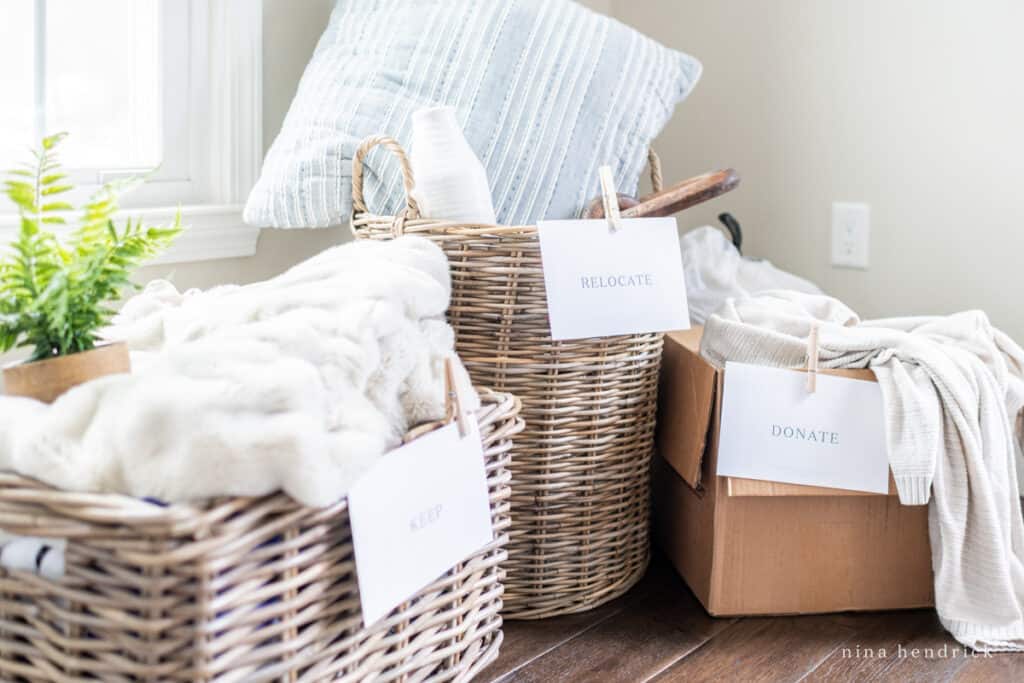
How to Declutter Your Home
Decluttering your home isn’t just about tidying up—it’s about creating a space that feels calm, functional, and truly yours. The best way to start? Have a simple plan. Take a moment to decide which areas need the most attention—whether it’s the cluttered kitchen counters, the overflowing closet, or the entryway that always seems to collect everything. Set a goal that feels manageable, whether that’s tackling an entire room or just one small space at a time.
Once you’re ready to dive in, sort your items into four categories:
- Keep (things you love, use, or truly need)
- Donate (items in good condition that can serve someone else)
- Sell (valuable pieces that deserve a second life)
- Toss (anything broken, expired, or beyond use)
As you declutter, be intentional about what stays. Organize what you’re keeping with simple storage solutions—bins, baskets, or drawer dividers—to make maintaining your space easier. And finally, take a moment to enjoy your refreshed space. Light a candle, pour yourself a cup of coffee, and appreciate the peace that comes with letting go of what no longer serves you.
Want a deeper dive into each step? Keep reading for my full decluttering process!
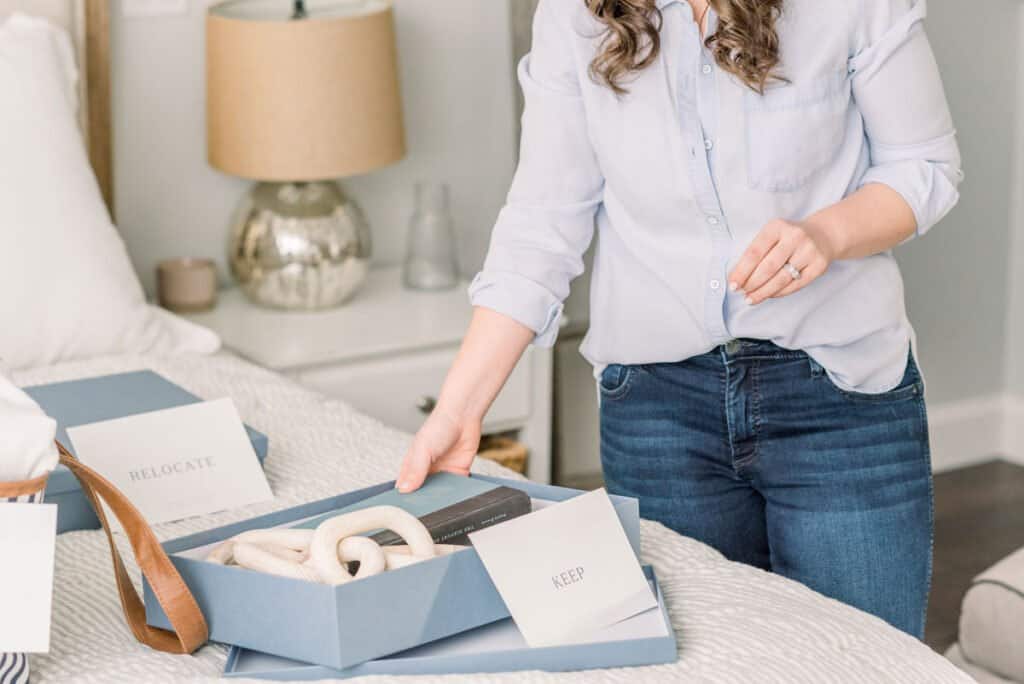
How do I start decluttering?
This is the question I’m asked the most often. And it makes sense. Because clutter can be overwhelming. That’s why my first step to organizing your home might surprise you.
To declutter your home, you need to adopt the right mindset.
Now the word mindset might sound a little “woo woo”, and I get that. You might be looking for more practical tips to declutter your home. We’ll get there, I promise.
But experts know mentally preparing for a task actually helps us complete it. Plus, living in a cluttered home — and taking the steps to remove that clutter — can actually bring up some really tough emotions. So it’s a good idea to address these head-on:
- Shame — when we look around and don’t feel proud of our homes, it can trigger feelings of shame. We say to ourselves, “How did I let this happen?” or “Why can’t I do a better job here”. Not only is this unpleasant, but it’s actually demotivating.
- Guilt — often, clutter comes from not wanting to let go of unnecessary things. We feel guilty for getting rid of a family heirloom or a gift we don’t want. After all, we were taught to be grateful. So, we let guilt talk us into keeping objects and things that don’t serve our lives.
- Regret — impulse purchases don’t always pan out. And if you regret wasting money, you might hold onto the object even though you don’t actually want or need it.
These feelings are all valid — and really common. But they’re not conducive to change. Instead, it’s important to get clear on your organization goals so you can focus on the positive emotions and outcomes. Rather than feeling paralyzed by guilt and shame, shift your mindset to focus on how you’ll feel when your house is tidy and clean.
To get in the right mindset for decluttering, ask yourself these questions:
- Why is decluttering a priority?
- How will it feel to live in a clutter-free environment?
- What stands in the way of you and the home you want to live in?
Be specific with your answers. Write them down and put them on the fridge or next to the bathroom mirror. Let them really sink in and motivate you to move forward. Then, set clear goals for decluttering your home.
Maybe you want to pair down your belongings by 20%. Or maybe you want to tackle 10 trouble spots in your home in the next 15 days. Make these goals measurable and achievable, so you can celebrate once you’ve reached them.
Once you’ve gotten clear on your goals, you can move on to the task of clearing out clutter.
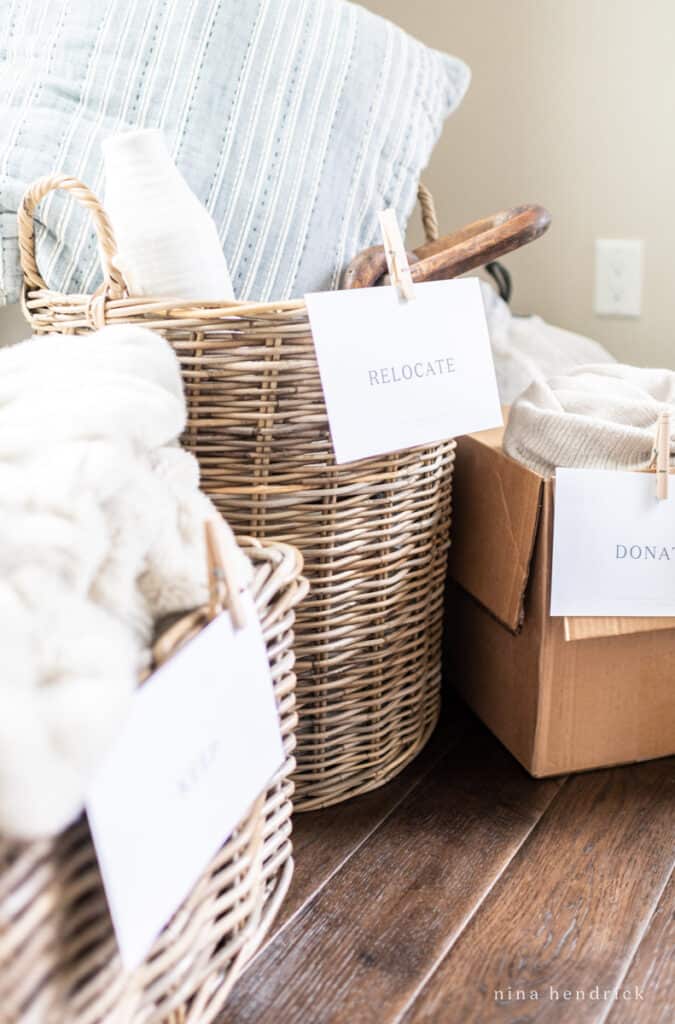
What should I get rid of when decluttering?
Here’s where most people really get stuck: how to decide what to keep and what to get rid of.
I get it. Our belongings are often tied to memories, experiences, and places we don’t want to forget. They remind us of another chapter of our lives. This is powerful stuff — and why the mindset piece is so important. It allows you to take a more objective approach to getting rid of clutter. Keep returning to your focus on the present, and the future you want to create, rather than memories of the past.
British designer, poet, and craftsman William Morris had a mantra:
Have nothing in your house that you do not know to be useful, or believe to be beautiful.
This statement provides two key questions to ask yourself as you’re assessing each object:
- Does this object serve a clear, tangible purpose in my life? Does it solve a problem or accomplish a task?
- Does this object add joy and beauty to my home?
If the answer to either question is yes, it’s a solid contender to keep. If not, ask yourself if you’re holding onto it for the wrong reasons (see negative emotions above).
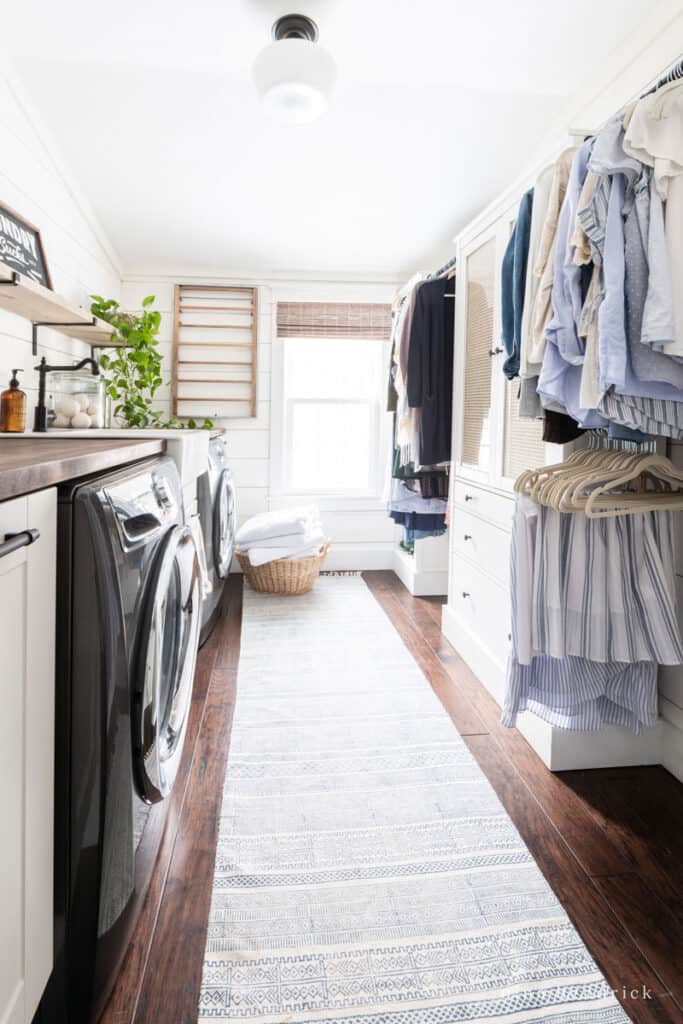
My 4-Step Decluttering and Home Organization Process
Like I said, I’m no rookie here. That’s because — while my home tends to stay clutter-free for the most part — I’m not naturally wired to be neat and tidy.
It’s true. If left to my own natural inclinations, the title of my memoir would be “Little Piles Everywhere”. Maybe The Life-Changing Magic of Overcoming Pack Rat Tendencies? I think it’s got bestseller potential, no?
But over the years, out of sheer frustration, desperate to tame the overwhelm, I’ve created and honed an organizational system that allowed me to get truly organized at the onset, and keep it that way in the day to day. We’re certainly not perfect — I mean, I’ve got 3 kids! But we typically stay about 20 minutes away from a truly clean and tidy house at all times.
Sound impossible? I swear, it’s not. If a recovering stacker like myself can do it, you can too. Here are my 4 steps for how to declutter and organize your home…
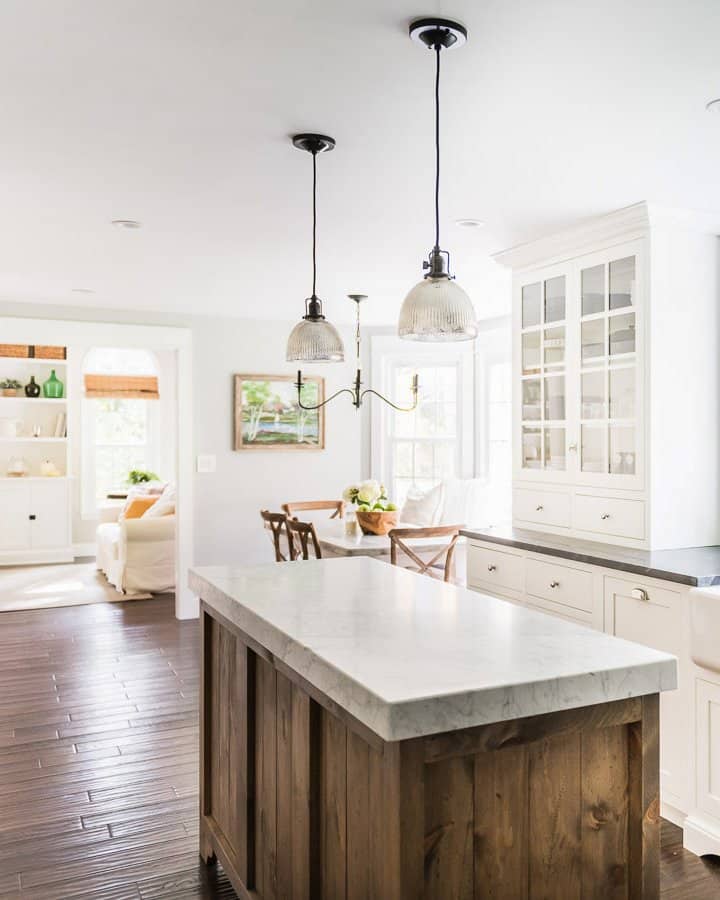
Step 1: Empty the Space
The first step to decluttering and organizing any space — your linen closet, your mudroom, wherever — is to empty the space. “But Nina, isn’t this harder than just moving things around?” Yes. But this step is the difference between making a space look decluttered and actually getting the results you want.
First of all, our minds are hardwired to find shortcuts. So if you’re staring at a row of shirts in your closet, trying to decide which ones to remove, you’ll probably take out a few and leave the rest. But, if you take them all out first, you override that mental progamming so you’re able to think critically about what you actually wear. You’ll put fewer back, leaving you with what you really, objectively need. (And, you’ll free up precious space for a closet that’s organized and calming instead of jam-packed).
Removing everything at the onset also allows you to rethink your storage and develop a plan that works better for your life. But it’s hard to envision a new solution when you’re staring at a closet that’s still filled with stuff. By starting with a clean slate, you’re able to really devise a functional storage plan that looks great now and helps you stay organized long-term.
So take everything out, my friend. Ev-er-y-thing. It’s also a good opportunity to give the room a nice deep cleaning while it’s empty! After that, you’re ready for step 2!
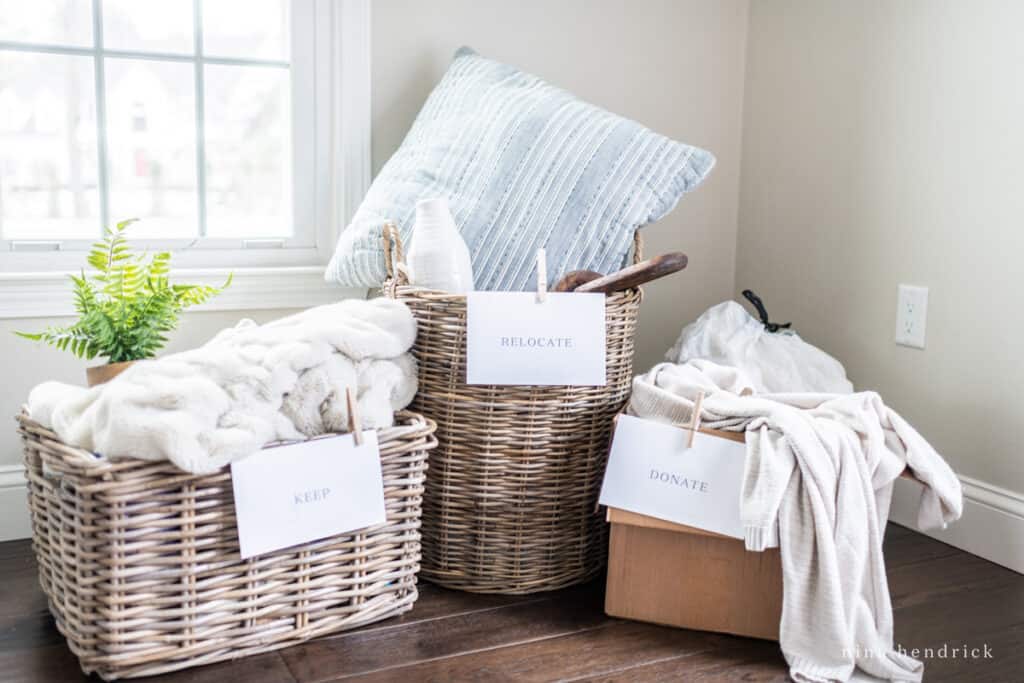
Step 2: Sort It Out
Now that everything is out of the closet and you’ve made a huge, colossal mess — congrats!! You’re ready to do some sorting. (Hold tight, friends, it gets better soon, I swear!)
A lot of home organization guides will tell you to create two or three categories, but I’ve found it pays to be more specific at the onset. Instead of simply ‘keep or toss’, I like to create 6 categories as I declutter my home:
- Keep
- Relocate
- Donate
- Recycle
- Sell
- Shred
By breaking up your piles into more specific categories, you make sure everything goes to the best place. Because home organization is a lot of work, my friends. And at the end of a project, it’s tempting to just put all the ‘keep’ stuff back in same the closet it came from. But that’s not always where it really belongs.
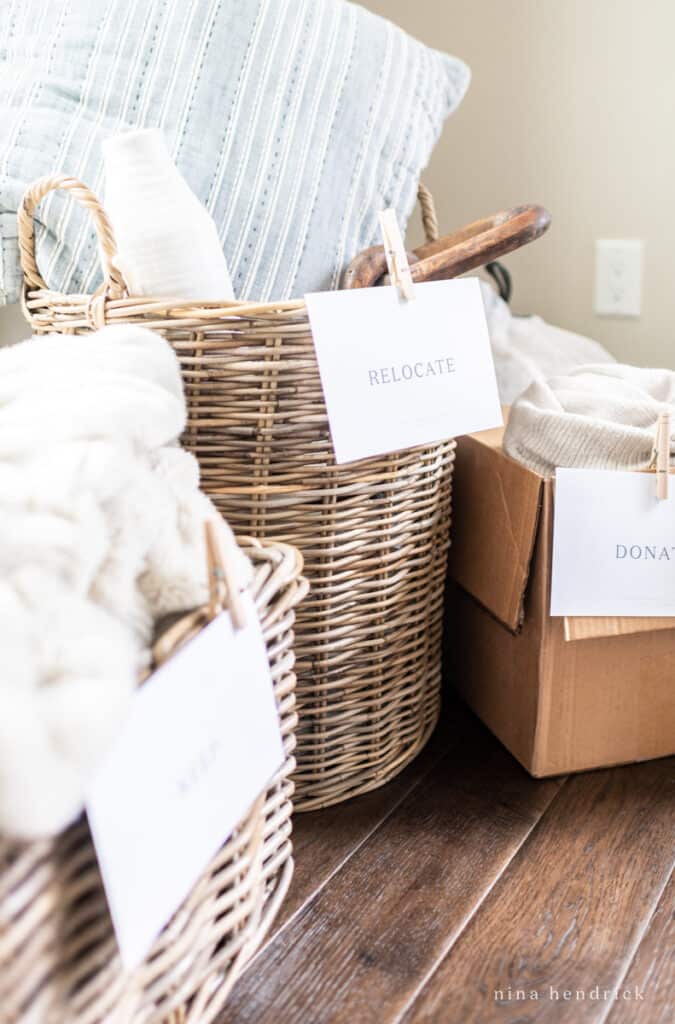
So as you’re decluttering, ask yourself:
- Do I love this item?
- Is this the best/most logical spot for it?
- Could someone else use it more than me?
- Can I recycle it?
- Is it valuable?
Use these questions to sort your stuff into the appropriate piles. Obviously the shred category is great for areas with papers, but it applies to closets, too. Got t-shirts or towels that are past their prime? Instead of throwing them away, could they be repurposed into cleaning rags? I love to see how much I can purge while finding creative solutions to keep things out of landfills.
Once you’ve sorted everything into your 6 categories, it’s on to step 3…
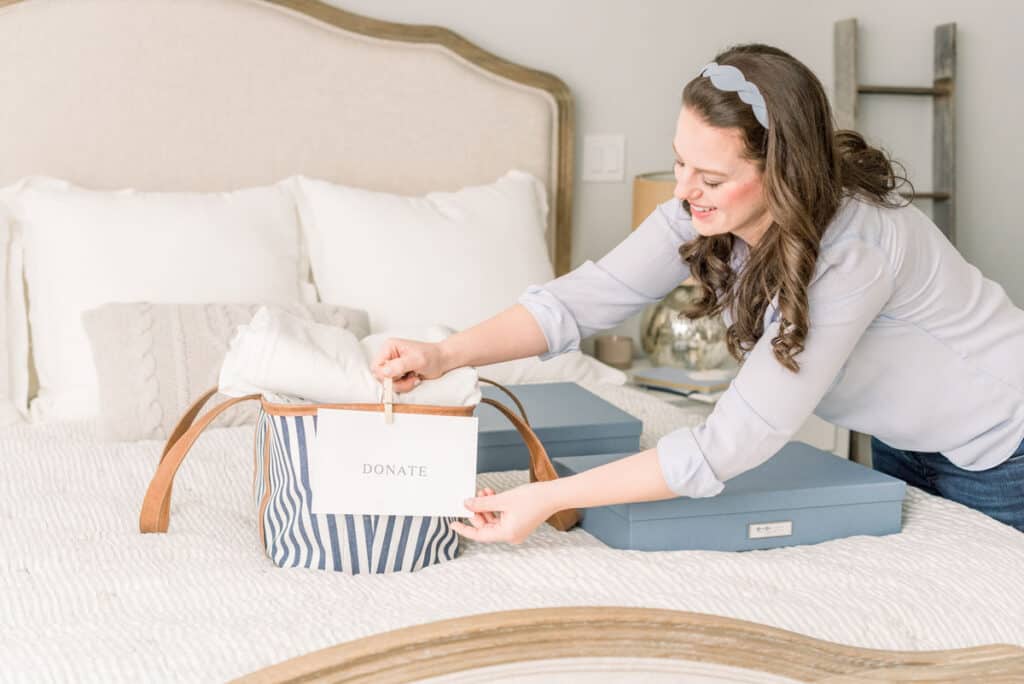
Step 3: Make a Plan
Now’s where the real fun begins! You’re ready to envision and plan your new, beautifully organized space.
First, remove everything but the “Keep” pile from the space. Put recyclables away, move the donate box to the car…get everything out of the space so you’re not tempted to just put it back where it came from.
Then, take a look at what’s left and create a plan to put it away. I’m a visual person, so I love to take measurements of the space and draw up a little sketch. I want to stress this point, friends: you do not need to go out and buy hundreds of dollars worth of home organizational systems.
It’s so tempting, I get it. And they can be really helpful. But you might have exactly what you need already (in another closet, perhaps?). So take inventory and get creative.
As you create your home organization plan, think about how you use each item, and how often. Daily use items should be front and center. Seasonal things can go on higher shelves.
And if you’re using baskets and closed storage — make labels. These can be unused adhesive nametags or paper tags from the craft store. Just get clear about what belongs — and what doesn’t — in each container.
And now, you’re ready for the final step…
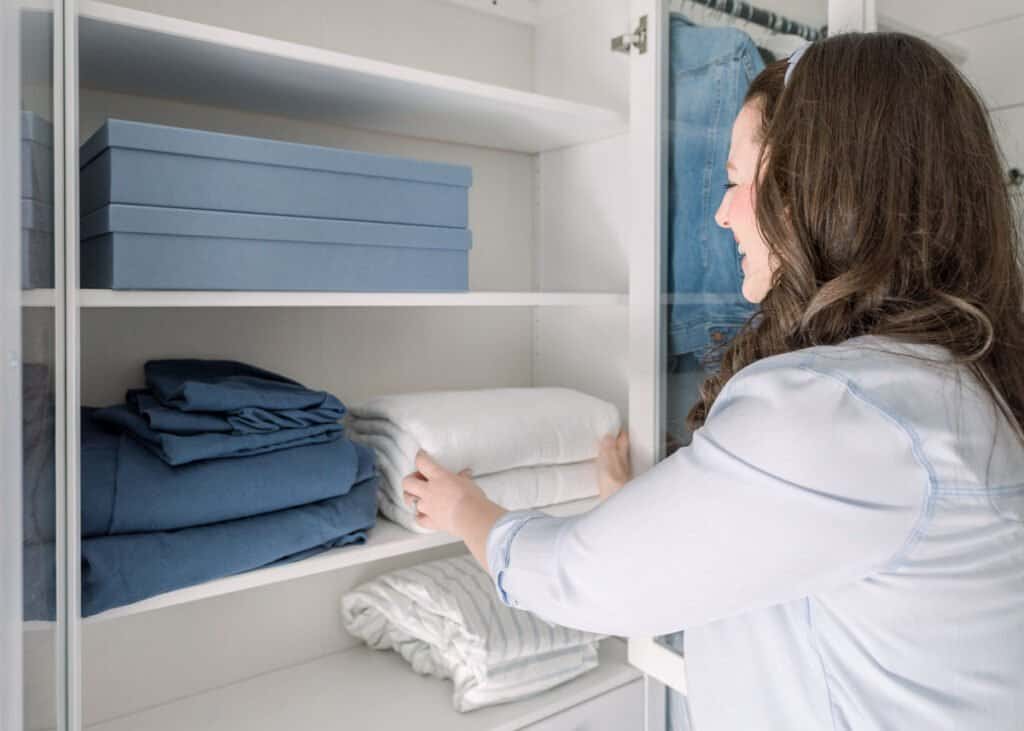
Step 4: Put Everything Away
You’ve done all the hard work, now comes the payoff! Sticking to your new organizational plan, put everything away in its designated place. Honestly, it’s a more in-depth topic than we can cover here, so make sure to check out my master post of home organization tips.
By this final step, you should have a really clear idea of what exactly goes into the space. But continue to check in — does this item really belong here? Will it get used? Make sure every single item you put back is exactly where it belongs.
How to Stay Organized
There! Doesn’t that feel amazing!? Take a second to step back and really admire your hard work. Take a picture of that beautiful space (and tag me @byninahendrick if you post it!).
The initial task is done, but as you know, it’s an ongoing battle to keep clutter at bay. The answer for how to stay organized is ongoing maintenance. That’s why my family does little resets — often in less than 10 minutes — each day. To target our most clutter-prone spots and prevent things from getting out of control in the first place.
Want some help to declutter your home?
Even with the right mindset and clear goals in place, decluttering can be an overwhelming task. That’s why I’ve put together a digital kit to help you declutter your entire house quickly, efficiently, and for good. It’s the next best thing to having a professional right there beside you teaching you how to declutter!
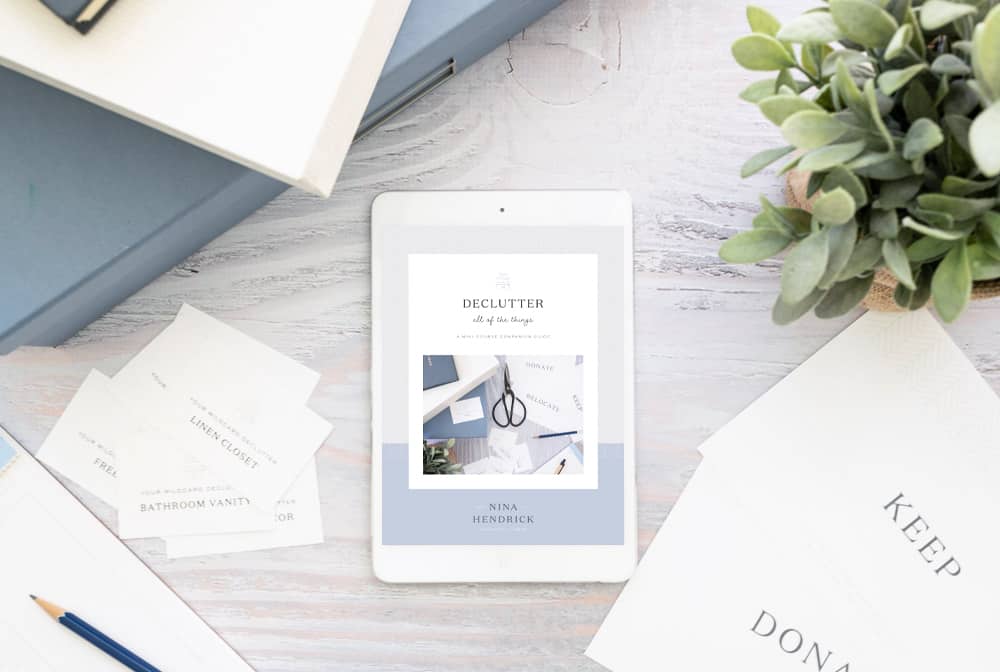
In the Declutter All of the Things KIT, I provide:
- Over 20 printable pages of guidance to help declutter your home
- A questionnaire to establish a healthy mindset and help you set clear goals (so you actually reach them!)
- Clear, step-by-step instructions to help you get started decluttering — and finish the job
- Printable signs and checklists so you stay organized throughout the process
- Ideas for repurposing and donating things you no longer need
- A guided 30-day plan to tackle the trickiest spots in your home — the mudroom, your desktop, that linen closet!
- My favorite tried-and-true-tips to keep your whole home clutter-free.
This digital kit also includes a troubleshooting guide to avoid common pitfalls along the decluttering journey. Whether you have unmotivated kiddos, a sentimental spouse, or a mountain of family photos and memorabilia you just can’t seem to keep corralled. I’ve thought of clear solutions for you, friend.

And finally, I’m sharing the wildcard system my own family uses to stay on top of clutter and keep it under control for good. Simply cut the cards from the printable and you have a fun and easy way to keep trouble areas clutter-free — in less time than your kids’ favorite episode of Paw Patrol.
You deserve to love where you live. To have a home you’re proud of. One that feels peaceful and calm, without the mad dash of last-minute closet-stashing before company arrives.
Grab the Declutter All of the Things kit here to get every tool you need for the home you want.
What comes next?
If you’re looking for some inspiration for how to organize after decluttering, check out my organized pantry tips, IKEA hack closet project, and how I organized my daughters closet.


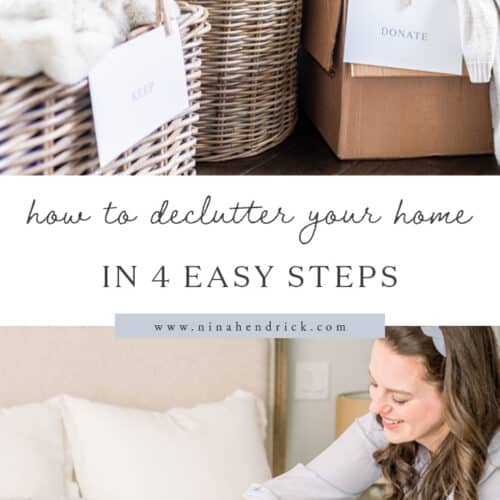
We are in the process of downsizing, leaving our home of 30 years where we raised our children. The hardest thing for me to get rid of has been my grandparents bedroom suit. I lovingly restored it as a young woman, rescuing it from near ruin where it had been stored by my parents, and now it is now almost 100 years old. No one in my family wants it but we have figured out a way to keep it in storage fat least in the short term.
I can only imagine how emotional it must be to leave a home filled with so many memories and to make decisions about treasured family pieces. Your grandparents’ bedroom set sounds like it holds an incredible history—not just from its original owners but also from the love and care you put into restoring it. I admire how you’ve found a way to hold onto it, at least for now. Sometimes, just giving ourselves time and space to make those decisions helps. Wishing you peace and comfort as you navigate this transition!
How do I subscribe to your emails/blog for new tips?
Thank you, Melanie
Hi, Melanie! You can sign up at https://www.ninahendrick.com/subscribe/! :) Excited to have you join us!